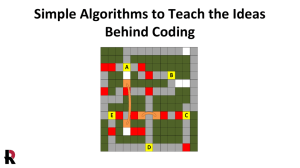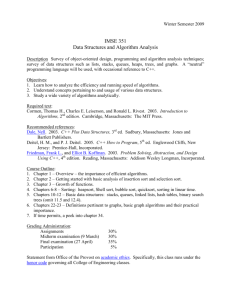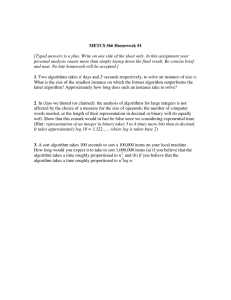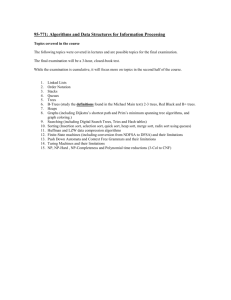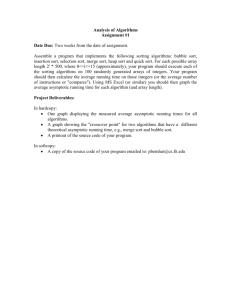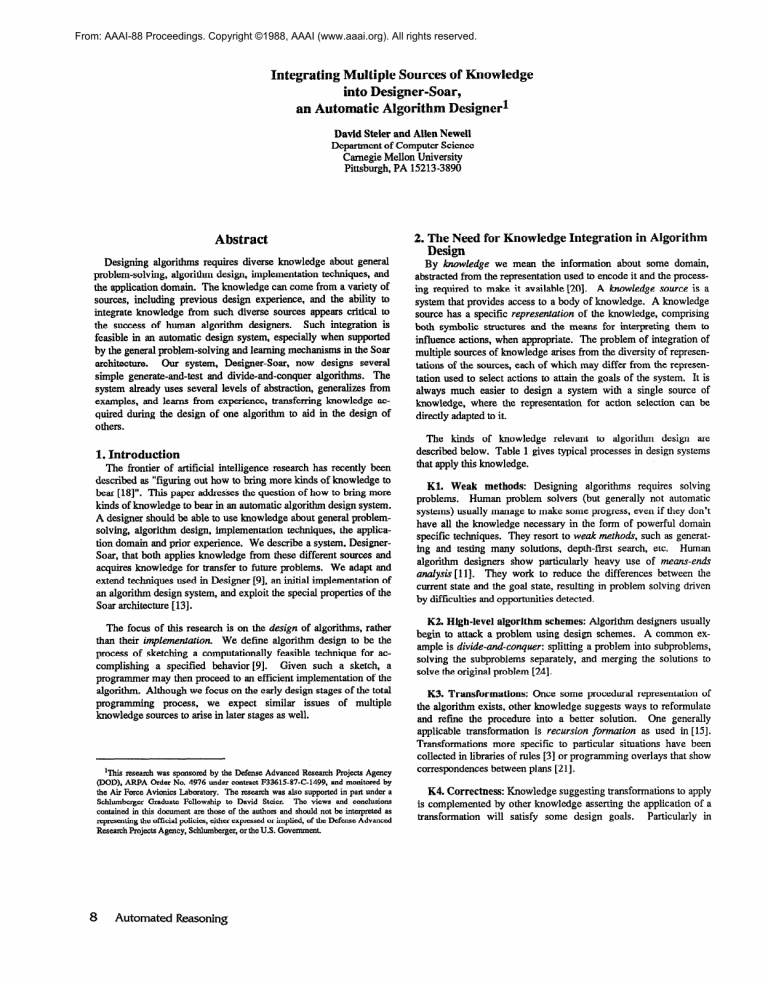
From: AAAI-88 Proceedings. Copyright ©1988, AAAI (www.aaai.org). All rights reserved.
Integrating
Multiple Sources of Knowledge
into Designer-Soar,
an Automatic Algorithm Desi
David Steier and Allen Newell
Department of Computer Science
Carnegie Mellon University
Pittsburgh, PA 15213-3890
Abstract
Designing algorithms requires diverse knowledge about general
problem-solving, algorithm design, implementation techniques, and
the application domain. The knowledge can come from a variety of
sources, including previous design experience, and the ability to
integrate larowledge from such diverse sources appears critical to
the success of human algorithm designers.
Such integration is
feasible in an automatic design system, especially when supported
by the general problem-solving and learning mechanisms in the Soar
Our system, Designer-Soar, now designs several
architecture.
simple generate-and-test and divide-and-conquer algorithms. The
system already uses several levels of abstraction, generalizes from
examples, and learns from experience, transferring knowledge acquired during the design of one algorithm to aid in the design of
others.
1. Introduction
The liontier of artificial intelligence research has recently been
described as “figuring out how to bring more kinds of knowledge to
bear [18]“. This paper addresses the question of how to bring more
kinds of knowledge to bear in an automatic algorithm design system.
A designer should be able to use knowledge about general problemsolving, algorithm design, implementation techniques, the application domain and prior experience. We describe a system, DesignerSoar, that both applies knowledge from these different sources and
acquires knowledge for transfer to future problems. We adapt and
extend techniques used in Designer [9], an initial implementation of
an algorithm design system, and exploit the special properties of the
Soar architecture [ 131.
The focus of this research is on the design of algorithms, rather
We define algorithm design to be the
than their irnplemetiation.
process of sketching a computationally feasible technique for accomplishing a specified behavior [9].
Given such a sketch, a
programmer may then proceed to an efficient implementation of the
algorithm. Although we focus on the early design stages of the total
programming process, we expect similar issues of multiple
knowledge sources to arise in later stages as well.
‘This research was span somd by the Defense Advanced Research Projects Agency
(DOD), ARPA Order No. 4976 under contract F3361587-C-1499,
and monitored by
the Aii Force Avionics Laboratory.
The research was also supported in paxt under a
Schl~berger
Graduate Fellowship to David Skier.
The views and conclusions
contained in this document are those of the authors and should not be intapreted as
representing the official policies, either expressed or implied, of the Defense Advanced
Research Projects Agency, Schlumberger, or the U.S. Government.
8
Automated Reasoning
2. The Need for Knowledge Integration in Algorithm
Design
By knowledge we mean the information about some domain,
abstracted from the representation used to encode it and the processing required to make it available [20]. A knavledge source is a
system that provides access to a body of knowledge. A knowledge
source has a specific representation of the knowledge, comprising
both symbolic structures and the means for interpreting them to
influence actions, when appropriate. The problem of integration of
multiple sources of knowledge arises from the diversity of representations of the sources, each of which may differ from the representation used to select actions to attain the goals of the system. It is
always much easier to design a system with a single source of
knowledge, where the representation for action selection can be
directly adapted to it.
The kids
of knowledge relevant to algorithm design are
described below. Table 1 gives typical processes in design systems
that apply this knowledge.
KL Weak methods: Designing algorithms requires solving
problems.
Human problem solvers (but generally not automatic
systems) usually manage to make some progress, even if they don’t
have all the knowledge necessary in the form of powerful domain
specific techniques. They resort to weak m&hods, such as generatHuman
ing and testing many solutions, depth-first search, etc.
algorithm designers show particularly heavy use of means-ends
~~2y.ri.r [l 11. They work to reduce the differences between the
current state and the goal state, resulting in problem solving driven
by difficulties and opportunities detected.
K2. High-level algorithm schemes: Algorithm designers usually
begin to attack a problem using design schemes. A common example is divide-and-conquer:
splitting a problem into subproblems,
solving the subproblems separately, and merging the solutions to
solve the original problem [24].
K3. Transformations:
Once some procedural representation of
the algorithm exists, other knowledge suggests ways to reformulate
One generally
and refine the procedure into a better solution.
applicable transformation is recursion formation as used in [ 151.
Transformations more specific to particular situations have been
collected in libraries of rules [3] or programming overlays that show
correspondences between plans [21].
K4. Correctness: Knowledge suggesting transformations to apply
is complemented by other knowledge asserting the application of a
Particularly in
transformation will satisfy some design goals.
General area
Knowledge
Typical processes
for applying knowledge
I
Problem solving
Kl. Weak methods
Predefined search procedure
Algorithm
design
and imphnentation
k2. High-level algorithm schemes
Instantiation of design templates
Apptication
domain
Past experience
K3. Transformations
Application of transformation rules
M4. Correctness
Testing designs, proofs
W. Efficiency
Performance analysis
K6. Target language and architecture
Application of selection rules
K7. Domain definitions
Inference from domain axioms
K8. Domain procedures
Generalization from examples
K9. Learned knowledge (Kl - K8)
Derivational analogy
Table I:
Knowledge sources in algorithm design
derivation systems developed by the program transformation community, transformations are known to preserve desired semantic
properties in program descriptions.
But sometimes there is no
knowledge that any known transformations preserve the desired
property. One way to acquire this knowledge is to prove the transformation correct; another is to apply a transformation and test the
results by executing the resulting design [26].
KS. Efficiency: Knowledge about efficiency may take several
forms. It is useful to know that extra effort devoted to finding a
divide-and-conquer algorithm may ultimately yield a more efficient
The baluncing
algorithm than a generate-and-test scheme [9].
principle,
which applies specifically to divide-and-conquer algorithms, state that the optimal divide step produces subproblems of
equal size.
K6. Target language and architecture: Knowledge about the
intended target language and architecture is mainly important in the
later (coding) stages of program synthesis [3,4].
However, the
availability of certain language features (e.g., bit operations) may
influence the choice of algorithm used; architectural features (e.g.,
parallelism) may create opportunities for using algorithms that
would be otherwise impossible.
K7. Domain definitions: As with programming in general [4],
algorithm specification and design require domain knowledge. For
example, in specifying a sorting algorithm, Clark and Darlington use
logical axioms and lemmas to give the semantics of the terms
ordered and permutation [5]. Other types of domain knowledge
provide performance constraints, input data characteristics, etc.
Kg. Domain procedures: Human designers invariably understand the algorithm specifications procedurally. No one designs a
sorting algorithm who does not know how to sort. Novice LISP
programmers often solve sample problems by hand, and then map
the structure of their hand solution onto LISP [l]. Using examples
provides a focus of attention for reasoning, excluding irrelevant
attributes and unrealistic situations that might result from exclusive
use of an abstract domain theory [17].
K9. Learned knowledge (KI - Kg): Human designers learn from
acquiring knowledge ranging from specific subexperience,
procedures to general design techniques. The importance of reuse
for automation
of programming
is commonly
recognized
[2,6,7, 191, but we are only beginning to understand how
automatic programming systems can learn 18,251.
Each type of knowledge has been incorporated into at least one
system for automating algorithm design or other phases of programTable 2 indicates the degree to which such systems
ming.
(including Designer-Soar) integrate multiple sources of knowledge.
The top half of the table lists systems that emphasize algorithm
design: Designer-Soar, Designer [lo], Cypress [24], Cypress-Soatj?
[25], MEDUSA [16], and STRATA [14]. The second half of the
table lists systems that emphasize other parts of programming:
DEDAIUS [15], PSI/SYN [12], Glitter [7], @m [4], KBEMACS
[28] and DRACQ [19].
The table shows that no single system integrates all the sources of
knowledge.
Weak methods, domain procedures, and learned
knowledge are used most infrequently. As expected, the systems
that emphasize algorithm design use less knowledge of the target
language and architecture than the other systems. Also, those systems most strongly driven to handle difficult real-world problems
are the ones that incorporate (or plan to incorporate) the most types
of knowledge. This is particularly true of aNM, which is intended
to produce usable oil well logging software, and DRACO, which has
been used for the analysis of domains such as real-time tactical
display systems.
e Task of Algorithm
The problem-solving architecture is critical to a system that permits integrating multiple, diverse knowledge sources.
The Soar
architecture [ 131 appears to have the requisite generality. Soar systems have solved problems and learned in domains ranging from the
traditional AI toy problems such as the eight-puzzle to more complex knowledge-intensive tasks, such as part of the VAX configuration performed by the Rl expert system [22]. Soar also provides a
way to explore transfer of learned knowledge both within a design
and between designs.
Soar represents tasks as search in problem spaces: sets of states,
with operators that move from state to state, and the free ability to
search within the space for a desired state that represents task
accomplishment. Knowledge is embodied in productions, which are
used
to select problem spaces, states, and operators. Productions
also implement simple operators, complex operators being treated as
ZCypress-Soar and Designer-Soar am both Soar-based algorithm designers. Cypresssoa assumes he use of a deductive engine to formally dezive divide-and-conqua
dg&h,
while Jkigner-Soar
designs these and other algorithms without such a
deductive engine, relying heavily on the use of examples as
a sourceoftiOWr&Je.
Steier and Newell
9
System
K2.
Kl.
DesignerSoar
Algorithm
schemes
Transformations
+
+
+
+
+
+
+
+
+
Designer
QpSS
Cypress-Soar
K3.
Weak
methods
+
K4.
Correctness
Target
hwge
Domain
Domain
definitions
procedures
K9.
Learned
knowledge
+
+
+
+
+
KS.
K6.
+
+
+
+
+
MEDUSA
+
+
STR4TA
+
+
+
+
+
+
+
+
+
+
+
+
+
+
+
+
+
+
+
+
PSUSYN
+
+
Glitter
+
+
+
%x
+
PA
+
DRACO
+
_
+
KS.
K7.
+
DEDALUS
+
+
+
+
t
+
t
= Knowledge applied in system
= Knowledge applied to a small degree
= Knowledge application planned for system
Table 2:
Knowledge integration in algorithm design and automatic programming systems
tasks, which are accomplished in appropriate problem spaces. With
insufficient or conflicting knowledge, Soar reaches an impasse and
generates a subgoal to resolve it. When subgoals are terminated,
Soar learns from the experience by building new productions,
chunk.r. The left-hand side of a chunk consists of generalized
conditions on the working memory elements used in producing the
results of the subgoal. If these conditions become true again, the
chunk will fire to automatically apply the knowledge from the
previous solution, and avoid the subgoal. Transfer of knowledge
occurs because the chunk’s conditions abstract away from inessential features of the original situation.
Design tasks are given to Designer-Soar in terms of two sets of
problem spaces. One defmes the computational model; its operators
are the primitives in which to express the algorithm. The other
defines the application domain of the algorithm. The desired behavior of the algorithm can be operationally specified by the system
knowing how to perform the task in the domain. Thus, DesignerSoar understands sorting if it can sort sequences in the domain
space. The algorithm design task is to express sorting in the computational model, which (for algorithm design, as opposed to programming in a specific language) is a space that has abstract
operators that correspond to the capabilities of computers. The total
specification of the &sign task may require additional subspaces to
define the operators and additional operational knowledge about
how to work within the two main spaces. Additional constraints
may come from performance requirements on the algorithm or from
resource limitations on the design process itself.
This definition of the task of algorithm design separates the understanding of what the algorithm is to do from the creation of an
algorithm within some computational framework. If Designer-Soar
does not know how to sort at all, then it must fiist acquire that
understanding, which will occur as a capability within the domain
space for sorting, namely, a space of abstract sequences. Designer-
10
Efficiency
Automated Raoning
Soar designs the algorithm by working in the computational space
until it can perform the task (e.g., sorting) in a functionally equivalent way to the domain-space algorithm, while satisfying the given
constraints. The chunks that are learned for the target computational
spaces implement an algorithm.
4.
owledge Integration in Designer-Soar
We will discuss knowledge integration in Designer-Soar by the
example of designing insertion sort, which Designer-Soar synthesizes in the same form as that created by Cypress [23] and
Cypress-Soar [25]. The algorithm is two divide-and-conquer algorithms, one for the top level sort function and one for inserting an
element into an ordered sequence (the composition subprocedure).
Sort takes a sequence of elements to be sorted as input. If the
sequence is empty, it is returned directly as already sorted, otherwise
the sequence is split into its first element and the rest of the sequence. The first element is then inserted into the result of recursively sorting the remainder of the sequence. Insert takes an element and an ordered sequence as input. If the sequence is empty,
the function returns a sequence containing only the element; otherwise, a conditional subprogram is called to decompose the input into
smaller subproblems. The subprogram compares the value of the
element parameter to the value of first element of the sequence
parameter. If we assume x0 corresponds to the smaller element, x1
to the larger element, and x2 to the remainder of the sequence, the
conditional returns a pair of the form oc0,cx1,x2>>.
The first
parameter is then prepended to the result of recursively calling the
insertion function on the second parameter (the nested pair).
The target computational model space has dataflow operators that
correspond to the conceptual building blocks for algorithms, such as
test a data item for some predicate, and apply some functionto
data [ll].
Algorithm schemes can be encoded procedurally as
higher-level operators that are implemented in terms of these build-
Effects of choice
Choice
(decision
cycle)
Specification:
Rationale for choice
Knowledge used
K7, K8
Sort integersequence Domain procedure acquired by TAQ
C2. (216)
Sort scheme: Divide-and-conquer
C3. (227)
Sort DivConq
pose
Abstract lookahead
Simple decom-
form:
Kl, K2, K4, K8
Pre-selected preference
=,
W51
I
C4. (227)
Sort decomposition:
Sort
decomposability
Length(ZqW)>O
C6. (285)
Sort directly-solve:
Preselected
F ir stRe st
preference
1~3.~6
F ir s t Re st decomposes example in-
test:
Domain op says empty sequence
Id
K4, K7
I
IPut
is
K4, K7, K8
Isorted
Abstract lookahead
Kl, K2, K4, K8, K9
Pre-selected preference
=,
Can’t decompose empty sequence
K4, K7
Cons returns desired result
Kl, K6, K8
Domain execution shows two possibilities for returning results
Kl, K3, K4, K8
Insertion
decompose
predicate:
ini-param 1 Firs t(seq-param)
Need ordered result for composition
K4, K7, K8
Insertion decompose
true branch:
ins-param first in returned result
Ensure smallest element moved to front
in example
K3, K4, K9
Insertion
Ensure smallest element moved to front
in new example
K3, K4, K9
Cons returns desired result
Kl, K6, K8
Insertion scheme: Divide-and-conquer
C8. (365)
Insertion
compose
form:
Simple
C9. (366)
decomposability
Insertion
Length(seq-pararn)>O
test:
DivConq
Insertion directly-solve:
Insertion
ditional
C13. (582)
decompose
decompose
Cons
scheme:
false
Con-
branch:
First(seq-purum)
first
in returned
K51
result
Insertion composition:
Cons
Table 3:
Insertion-sort design in Designer-Soar
ing blocks.
For example, Designer-Soar has compose
and
de compose operators that correspond to decomposing problems
into subproblems, and composing subproblems solutions to get the
answer to the original problem,. These are not implemented directly
by productions. When attempting to apply these operators in executing an algorithm, an impasse results, with a corresponding sub
goal to acquire the knowledge to implement them. Designer-Soar
knows an algorithm when it can select and implement the ap
propriate dataflow operators to compute the correct output given any
legal input. This uniform procedural representation of abstractions
at levels varying from algorithm schemes down to computational
primitives is crucial to knowledge integration in Designer-Soar.
The design of insertion sort is summarized in Table 3. Cohunn 1
labels the design choice and gives the decision cycle at which the
choice occured. The decision cycle is the basic unit of problem
solving effort in Soar (the entire run takes 883 decision cycles,
requiring about 35 minutes on a Sun3/260). Column 2 summarizes
the design choices; column 3 gives Designer-Soar’s reasons for
making the choice. Column 4 lists the types of knowledge used for
each choice. We describe the design process in more detail in the
following subsections.
e specification
and a plan (Cl - CZ)
The goal of algorithm design is to be able to know what to do to
execute the algorithm on any valid input. Designer-Soar makes
design choices while repeatedly executing both the domain proce-
dure and the partially designed algorithm at varying levels of
The results of the executions are used to detect
abstraction.
problems and opportunities that guide the design so that the design
process can be characterized more as means-ends-analysis than as
strict topdown refinement.
Designer-Soar first attempts to execute the insertion-sort algorithm (which doesn’t exist yet) to see what needs to be done. An
impasse is generated because Designer-Soar has not yet learned how
to select between the computational operators it could apply as a
first step. While resolving this impasse, Designer-Soar learns that
thealgorithm
should
have thefunctionality
ofthehigh-level
domain
operator "sort a sequence into nondecreasing order.” DesignerSoar already has the knowledge to implement sort in domain
spaces, but acquires the knowledge to select the sort operator for
this run by translating an external task description into an internal
description of the operator selection knowledge, and then interpreting this description to build a procedural representation of the
knowledge as an operator selection chunk [29].
Knowledge that the algorithm must sort is used to select an
operator to apply in the computational space. The operator selected
implements the first step of divide-and-conquer: a test to check if the
input is decomposable.
The operator is selected according to the
results of a subgoal to evaluate the choice by lookahead, i.e., trying
out the operator to see if it leads to a final state. The exact test for
decomposability is not yet known and no concrete examplehas
Steier
and Newell
11
been produced to refine it. Therefore, the lookahead takes place in
an abstracted version of the computational space, in which the
operators can be applied without knowing the missing details3. Currently, Designer-Soar only uses type knowledge in abstracted execution, but we expect to propagate efficiency constraints as well.
4.2. Designing the top level sort (C3 - C6)
Given the decision to execute a divide-and-conquer algorithm,
Designer-Soar attempts to apply the first step, testing for decomposability. The test is not known, but the system knows that execution on concrete examples is useful for refining tests, so a new
execution pass is begun. An example of the input required, a
sequence of integers, is incrementally generated by adding elements
to an initially empty sequence until it has two elements. DesignerSoar knows that sequences with two or more elements will probably
not be boundary cases (in contrast to zero or one elements). To find
the test for decomposability, Designer-Soar looks ahead for a possible decomposition operator. We have told the system to select the
First Re s t operator for decomposition in this case (which leads to
insertion sort rather than other sorting algorithms), splitting off the
first element from the sequence containing the second element. The
precondition for applying F i r s t Re s t - that the sequence has at
least one element - is used as the test for decomposability.
The subproblems from this decomposition are then solved. The
first subproblem is an element rather than a sortable sequence, and is
passed to the composition as is. The remaining subproblem is a
sequence, and test-case execution is recursively invoked to sort it. It
is decomposed into an element and an empty sequence. The test for
decomposability applied to the empty sequence returns false, so it
must be sorted directly. Applying the domain operator to sort the
empty sequence shows that the computational space operator Id
(identity) operator has the necessary functionality.
4.3. Designing 1
--IL--
current example, it knows that the purpose of the execution is not
only to obtain the answer, but also to exercise the execution paths so
that it learns the algorithm. In finding that the test for decomposability returns false, it remembers it must come back to find out
what happens when a test returns true. It generates a new example
to force the execution down the untried path, adding an element to
the sequence to make it decomposable.
In processing the new example and looking at the results of
domain execution, the system discovers that it needs to handle
several cases separately for the decomposition.
This leads to a
conditional algorithm, where inputs are an element and an ordered
sequence. Another execution pass refines the predicate of the conditional to compare the value of the element to the value of the first
element of the sequence, and also refines the true branch to ensure
that the smaller of the two elements is moved to the front. Some of
the knowledge learned in refining the true branch is used together
with a new example to refine the false branch analogously. While
finishing the design, the composition operation of the insertion is
refined to cons the element (known to be smallest) to the front.
4.5. Learning
Prior experience is a significant source of knowledge for design.
Soar’s learning mechanism, chunking, is so tightly integrated into
Designer-Soar that the boundary between problem-solving and
learning has disappeared: designing an algorithm is equivalent to
learning to execute it and the current Designer-Soar requires that
chunking be on to run. However, a slightly earlier version of
Designer-Soar did permit no-chunking runs so as to isolate the
effects of learning.
Figure 4-l shows the cumulative problemsolving effort needed to design two simple algorithms in sequence,
with and without chunking. Gn the left, the first algorithm finds the
subset of elements satisfying a given predicate in a given
set, the
second finds the intersection of two sets. Gn the right, the two
algorithms are insertion sort and merge sort. There is a significant
savings from learning in both pairs of algorithms: 28% for the set
algorithms and 69% for the sorting algorithms, illustrating that the
benefits of learning increase as the designs get more complex. Furthermore, the slope of the learning graph decreases during the design
of the second algorithm in each pair, suggesting transfer across, as
well as within the similar designs. We found that without the
chunks from the design of insertion sort, the learning run for merge
sort takes 860 decision cycles, an increase of 56% over the 551
needed with those chunks.
-Algorithm& designed
empty sequence.
4.4. Designing the decomposition
algorithm (Cl1 - Cl5)
Figure 4-1:
of the insertion
Though Designer-Soar has solved the problem of insertion for the
3A &-I&X use of abstraction in Soar has been described for a partial nimplementation
12
ofR1,
the VAX configuration expert system [27].
Automated Reasoning
Effects of learning in Designer-Soar
5. SumInary
Returning to our list of knowledge sources, we summarize the
mechanisms used for integrating each source into Designer-Soar.
The Soar architecture directly supports
access and use of two of the
knowledge sources: weak method search (Kl) results from Soar’s
default behavior in knowledge-lean
situations,
and learned
knowledge (Kg) is applied when chunks fire. The problem spaces
that are specific to Designer-Soar support integration of the other
sources. Knowledge of the high-level algorithm schemes (K2) and
of possible transformations (K3) is encoded in the operators in the
computational spaces.
Similarly, knowledge about application
domain definitions and procedures (K7 and K8) is embodied in the
structure of the domain spaces. Concerns of correctness (K4) are
addressed by execution in both computational and domain spaces,
and means-ends analysis on the results. Though we have not yet
focused on knowledge about efficiency (K5) or the target language
and architecture (K6), there is a clear role for integrating these
sources in terms of selection lmowledge in the computational space,
or even computational spaces with different functional operators.
Currently, Designer-Soar designs both generate-and-test and
divide-and-conquer algorithms, but only simple instances of each.
We are now reorganizing Designer-Soar to give it greater generality
and robustness. We expect that the results we obtain in integration
of multiple knowledge sources, including learning, will have implications not only for algorithm design, but for other applications as
well.
Acknowledgement
We thank Erik Altmann, Gregg Yost and Kathy Swedlow for their
comments on earlier drafts of this paper.
eferenees
12. Kant, E. and Barstow, D. R. The refinement paradigm: The
interaction of coding and efficiency knowledge in program synthesis. In Interactive Programming Environments, McGraw-Hill,
New York, 1984, pp. 487-513.
13. Laird, J. E., Newell, A., and Rosenbloom, P. S. “Soar: An
architecture for general intelligence”. Artificial Intelligence 33, 1
(1987), l-64.
14. Lowry, M. R. Algorithm synthesis through problem reformulation. Proceedings of the National Conference on Artificial
Intelligence, August, 1987, pp. 432-436.
15. Manna, 2. and Waldinger, R. “Synthesis: dreams =>
programs”. IEEE Transactions on Software Engineering SE-S, 4
(1979). 294-328.
16. McCartney, R. D. Synthesizing algorithms with performance
constraints. Proceedings of the National Conference on Artificial
Jntelligence, August, 1987, pp. 154-159.
17. Mitchell, T. M., Keller, R. M., and Kedar-Cabelli, S. T.
“Explanation-based generalization: A unifying view”. Machine
Learning 1.1 (1986), 47-80.
18. Mostow, D. J. “What is AI? And what does it have to do with
software engineering ?I’. IEEE Transactions on Software Engineering SE-II, 11 (1985), 1253-1256.
19. Neighbors, J. “The Draco approach to constructing software
from reusable components”. IEEE Transactions on Sojbvare Engineering SE-IO, 5 (1984), 564-574.
1. Anderson, J. R., Farrell, R., and Sauers, R. “Learning to program
in LISP”. Cognitive Science 8, 2 (1984), 87-129.
20. Newell, A. “The knowledge
(1982), 87-127.
2. Balzer, R. “A 15-year perspective on automatic programming”.
IEEE Transactions on Software Engimering SE-I 1, 11 (1985),
1257-1268.
21. Rich, C. Inspection methods in programming. Tech. Rept.
AI-TR 604, Massachusetts Institute of Technology, June, 1981.
3. Barstow, D. R.. Knowledge-Based
Program Construction.
North Holland Publishing Company, Amsterdam, 1979.
4. Barstow, D. R. ‘Domain-specific automatic programming”.
IEEE Transactions on Software Engineering SE-I 1, 11 (1985).
1321-1336.
5. Clark, K. and Darlington, J. “Algorithm classification
synthesis”. Computer Journal23, 1 (1980). 61-65.
6. Dietzen, S. R., and Scherlis, W. L. Analogy in program develop
ment. Proceedings of the Second Conference on the Role of Language in Problem Solving, April, 1986, pp. 95-l 13.
7. Fickas, S. “Automating the transformational development of
software”. IEEE Transactions on Software Engineering SE-Z I,1 I
(1985), 1268-1277.
8. Hill, W. L. Machine learning for software reuse. Proceedings of
the Tenth IInternational Joint Conference on Artificial Intelligence,
August, 1987, pp. 338-344.
9. Kant, E. “Understanding and automating algorithm design”.
IEEE Transactions on Software Engineering SE-I I, ll(1985).
1361-1374.
10. Kant, E., and Newell, A. An automatic algorithm designer: An
initial implementation. Proceedings of The National Conference on
Artificial Intelligence, August, 1983, pp. 177-18 1.
11. Kant, E. and Newell, A. “Problem solving techniques for the
design of algorithms”. Information Processing and Management 20,
l-2 (1984), 97-l 18.
level”. Artificial Intelligence
18, 1
22. Rosenbloom, P. S., Laird, J. E., McDermott, J., Newell, A., and
Grciuch, E. “Rl -Soar: An experiment in knowledge-intensive programming in a problem-solving architecture”. IEEE Transactions
on Pattern Analysis and Machine Intelligence 7.5 (1985), 561-569.
23. Smith, D. R. Top-down synthesis of simple divide-and-conquer
algorithms. Tech. Rept. NPS52-82-011, Navy Postgraduate School,
November, 1982.
24. Smith, D. R. “Top-down synthesis of divide-and-conquer
algorithms”. Artificial Intelligence 27, 1 (1985), 43-96.
25. Steier, D. M. Cypress-Soar: A case study in search and leaming in algorithm design. Proceedings of the Tenth International
Joint Conference on Artificial Intelligence, August, 1987, pp.
327-330.
26. Steier, D. M. and Kant, E. “The roles of execution and analysis
in algorithm design”. IEEE Transactions on Soware Engineering
SE-II, 11 (1985), 1375-1386.
27. Unruh, A., Rosenbloom, P. S., and Laird, J. E. Dynamic
abstraction problem solving in Soar. Proceedings of the Third
Annual Conference on Aerospace Applications of Artificial Jntelligence, October, 1987, pp. 245-256.
28. Waters, R. C. “The programmer’s apprentice: a session with
KBEmacs”. IEEE Transactions on SofhYare Engineering SE-1 1, 11
(1985), 1296-1320.
29. Yost, G. R. TAQ: Soar Task Acquisition System User Manual.
In preparation.
Steier
and Newell
13

